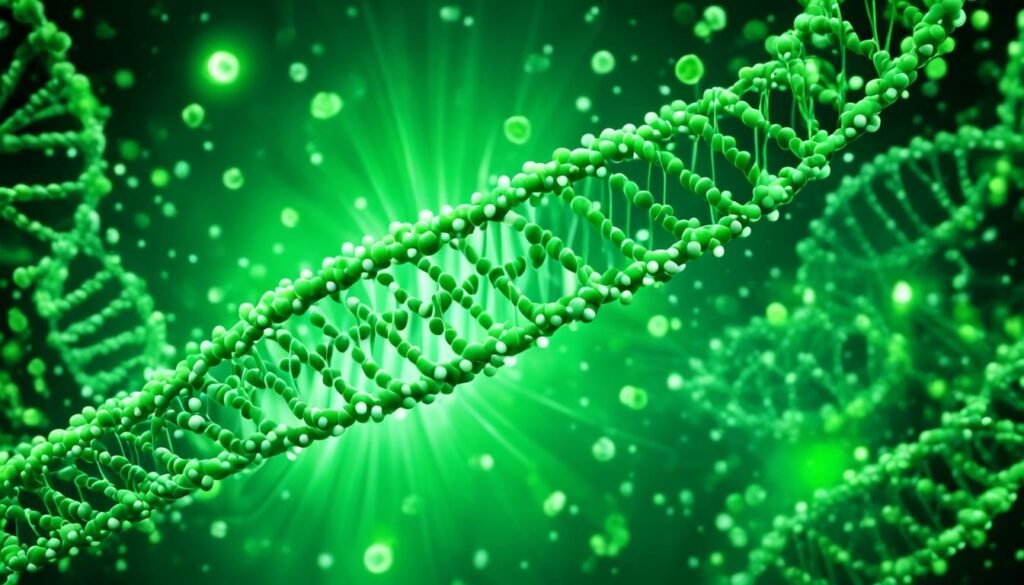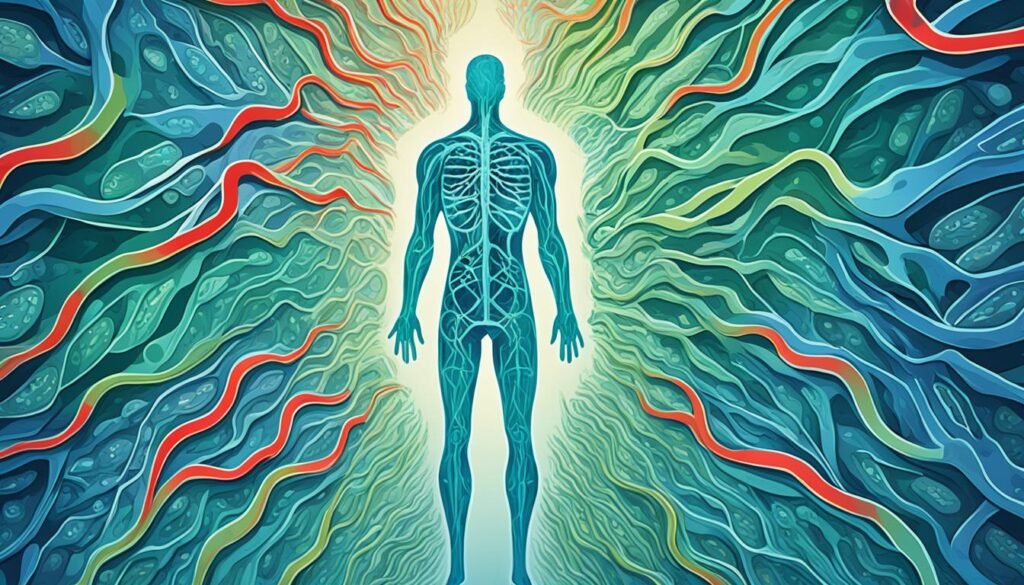Mitochondrial inheritance diseases are a type of genetic issue. They affect the energy production of your cells’ mitochondria. Since mitochondria create much of your body’s energy, this can be serious.
Those with these diseases find their cells struggling to make enough energy. As a result, they may face problems at any age. Often, these issues affect many body parts, especially the brain and muscles.
Unfortunately, there’s no cure for these conditions. However, treatments are available to help avoid very serious problems.
Table of Contents
ToggleUnderstanding Mitochondrial Inheritance
Mitochondrial inheritance is key to grasping mitochondrial diseases’ complexities. It involves two vital genetic parts: mitochondrial DNA (mtDNA) and nuclear DNA (nDNA).
Mitochondrial DNA (mtDNA)
Mitochondrial DNA (mtDNA) is inside the mitochondria, the cell’s powerhouses. It codes for 13 key parts of the energy-making process, known as the respiratory chain. This chain helps produce ATP, the cell’s energy source. Other parts vital for the mitochondria are coded by the nuclear genome (nDNA).
Nuclear DNA (nDNA) and Mitochondrial Function
The nuclear genome also helps run the mitochondria. It encodes many proteins and enzymes needed for the mitochondria’s shape and energy production.
This shows how important both mtDNA and nDNA are for understanding mitochondrial diseases.
Heteroplasmy and the Threshold Effect
People with mitochondrial issues might have a mix of healthy and faulty mtDNA in their cells. This mix is called heteroplasmy. For a cell to show any issues, the bad mtDNA must reach a certain level. This level is called the threshold. It can differ, causing various symptoms even in the same family.

Clinical Manifestations of Mitochondrial Inheritance Diseases
Mitochondrial inheritance diseases can affect our organs in many ways. They often show up with neurological and myopathic features. This leads to many different mitochondrial disease symptoms, showing that these diseases involve many parts of our body.
Multisystem Involvement
These diseases can cause ptosis, external ophthalmoplegia, and more. Symptoms include proximal myopathy, which is weakness in certain muscles, and not being able to exercise much. Cardiomyopathy, sensorineural deafness, diabetes, and more can also occur.
All these different symptoms highlight how crucial mitochondria are for making energy. They affect many parts of our body because of this.
Neurological and Myopathic Features
In these diseases, you might see problems like fluctuating encephalopathy and seizures. Some people have dementia or migraine headaches. There’s also stroke-like episodes, ataxia, and spasticity, which is stiffness of muscles.
Myopathic features are also common. This includes muscle weakness, cramping, and tiredness during physical activity. The mix of neurological and myopathic features is a key feature of these complex diseases.

Mitochondrial DNA Disorders
Many people with mitochondrial DNA (mtDNA) disorders fit into specific types, which helps with diagnosis and treatment. These types show different symptoms. Doctors use these symptoms to treat those with mitochondrial DNA disorders.
Common Syndromes and Characteristics
Some of the more well-known mtDNA disorder types are:
- Chronic Progressive External Ophthalmoplegia (CPEO): It causes a progressive weakness in the eye muscles. This results in droopy eyelids and trouble moving the eyes.
- Kearns-Sayre Syndrome (KSS): It combines CPEO, issues with the retina, and starts before age 20. It can also affect the heart and nerves.
- Pearson Syndrome: It mainly affects the bone marrow. This leads to a certain type of anemia and issues in the pancreas. Other organs like the liver, kidneys, and brain can also be involved.
- Leigh Syndrome: This disorder is severe and gets worse over time. It causes brainstem and basal ganglia damage. This can lead to slow development, shaky movements, and breathing issues.
- Neurogenic Weakness with Ataxia and Retinitis Pigmentosa (NARP): It shows up with weak muscles, balance problems, and an issue with the eyes. The nervous system might also be affected.
- Mitochondrial Encephalomyopathy with Lactic Acidosis and Stroke-like Episodes (MELAS): MELAS leads to stroke-like episodes, seizures, memory loss, and too much acid in the blood.
- Myoclonic Epilepsy with Ragged-Red Fibers (MERRF): This syndrome comes with muscle jerks, seizures, balance problems, and a specific finding on muscle tests.
These syndromes show how complex mitochondrial diseases are. They affect the brain, muscles, and many organs. Knowing these symptoms helps doctors diagnose and treat mtDNA disorders.

Nuclear DNA Mitochondrial Disorders
Nuclear DNA (nDNA) mitochondrial disorders show a wide range of symptoms. Those affected may not neatly fit into one type. They are grouped by how they change the body’s cells.
Issues in nDNA genes, like POLG, are a main cause of these disorders. These genetic issues create a range of diseases. They cause problems like muscle weakness and difficulty with movement.
Another kind of nDNA disorder affects genes controlling how mitochondria move and change shape. This can cause specific issues like eye problems. Problems in how mitochondria move and shape can lead to different symptoms in these cases.

Dealing with nDNA mitochondrial disorders needs careful testing and varied medical inputs. Learning more about these diseases at a genetic level is vital. It helps in developing better treatments and raising life quality for those affected.
Diagnosis and Evaluation Strategies
Diagnosing mitochondrial inheritance diseases needs both biochemical and genetic tests. These show how well the mitochondrial respiratory chain works and find the disease’s genetic causes.
Biochemical and Genetic Testing
Testing enzymes and metabolites can pinpoint what’s wrong with the patient’s respiratory chain. This helps with further testing and diagnosing mitochondrial diseases. Targeted or wide genetic tests can then find the genetic faults.
Prenatal Testing Considerations
For families with mitochondrial disease risk, prenatal testing matters a lot. This is because the amount of bad mtDNA changes across tissues and family members. Prenatal tests can show if the baby might have the disease and help with planning.
Mitochondrial inheritance diseases Treatment and Management
There is currently no cure for mitochondrial inheritance diseases. But, treatments focus on managing symptoms and avoiding severe complications. Care may include using medications, special devices, and other help tailored to the individual.
Exercise and Nutritional Therapy
Boosting energy production is key in managing mitochondrial disorders. A diet like ketogenic that enhances mitochondrial function is beneficial. Also, regular exercise maintains muscle strength and overall health in affected people.
Experimental Therapies
Scientists are also looking into new therapies for these diseases. This research involves gene therapy, enzyme replacement, and new drugs. These methods could significantly improve how we treat these conditions in the future.
Genetic Counseling for Mitochondrial Inheritance Diseases
Genetic counseling is vital for those dealing with mitochondrial inheritance diseases. These diseases are complex and have different ways of being passed on. This affects how we diagnose them, plan our families, and choose our options for having children. Knowing the genetic details helps us give the right advice to people and families living with these diseases.
Inheritance Patterns
Mitochondrial inheritance diseases can come from a mother, or from both parents. It all depends on if the gene changes are in the mitochondrial DNA or the nuclear DNA. With mother-to-child (maternal) inheritance, many mitochondrial disorders are inherited this way. Autosomal recessive and dominant patterns come from the nuclear DNA mutations. Each way of inheriting has its own effect on how likely children are to get the disease.
Reproductive Options
For families facing mitochondrial diseases, it’s good to look into different ways to have children. Preimplantation genetic testing, checking during pregnancy, and special assisted ways to have children are all possible. These include egg donation or getting healthy mitochondria from someone else. A genetic counselor can help families understand these options and the risk of passing the disease.
Current Research and Future Directions
Scientists are looking into new ways to diagnose and treat diseases that pass through families called mitochondrial inheritance diseases. They are using new genetic tests like whole-exome sequencing to find the causes of these diseases more accurately. By doing this, they hope to better diagnose the diseases and come up with plans that are just right for each person.
Ongoing Studies and Clinical Trials
The Children’s Hospital of Philadelphia (CHOP) is leading the way in research on mitochondrial diseases. They have made special models of these diseases to help try out different drugs faster. Plus, nearly 50 researchers from the Department of Defense are working on tests that don’t need to go inside the body to check how well mitochondria are working.
Another study looks at how problems with mitochondria might make cancer harder to treat. This study focuses on proteins in the mitochondria and how they respond to stress. It also looks at how mitochondria help the brain work normally, how it heals from injury, and why it might have mental health issues.
Emerging Therapies and Approaches
There is hope for new treatments for mitochondrial diseases. These might include gene therapy, treatments using stem cells, and drugs that target mitochondria to make them work better. The goal is to help manage the symptoms and make life better for those with these diseases.
For instance, CHOP received a big grant to find new ways to check mitochondrial health without needing surgery. They are also studying how to stop cancer cells from getting energy. A group called CureARS is working with CHOP to research treatments for these diseases that affect the nervous system.
Overall, the work being done now offers hope for better ways to diagnose, treat, and care for those with mitochondrial diseases. This could lead to a better quality of life for many people facing these challenging conditions.
Conclusion
Mitochondrial inheritance diseases are a wide group of genetic problems. They can really affect how our cells make energy. This causes many different health issues. It’s key to learn more about how these diseases work, find better ways to diagnose them, and create helpful treatments. There is a lot of ongoing teamwork and study aiming to make life better for people with these disorders.
The scientific world is making big strides in understanding mitochondrial diseases. This means better genetic tests, treatments, and care plans are on the horizon. By using new findings and creative methods, doctors can help more. They can explain, judge, and treat these conditions better. So, patients and their families can face these challenges with more hope and strength.
The fight against mitochondrial diseases is complex but full of promise. It involves grasping the deepest genetic and chemical workings. Plus, finding new ways to diagnose and treat. Through teamwork and relentless study, there’s hope to improve life for those with these diseases. Everyone is working together to find better solutions.
FAQ
What are mitochondrial inheritance diseases?
Mitochondrial inheritance diseases influence how body cells make energy. These conditions affect the function of mitochondria in cells. Mitochondria are essential for producing the energy our bodies need.
How do mitochondrial inheritance diseases affect the body?
These diseases can target many organ systems. They often lead to issues affecting the nervous system and muscles. You might see problems with eye movements, muscle weakness, and intolerance to exercise.
Other common signs include heart muscle problems, hearing loss, and vision issues. They can also cause a type of eye disorder and diabetes.
What are the different types of mitochondrial inheritance diseases?
There are two main types based on where the genetic issue is: mitochondrial DNA (mtDNA) disorders and nuclear DNA (nDNA) mitochondrial disorders.
mtDNA disorders can have certain symptoms in common. But, with nDNA disorders, the signs can vary a lot from person to person.
How are mitochondrial inheritance diseases diagnosed?
Diagnosing these diseases includes looking at both biochemistry and genes. Biochemical tests check mitochondrial function. Genetic tests find the genetic problems in mtDNA or nDNA.
If a family is at risk, prenatal testing can check for these disorders before birth.
How are mitochondrial inheritance diseases treated?
Currently, there’s no direct cure. Treatments focus on easing symptoms and avoiding serious problems.
This can include certain drugs, medical devices, and special diets. New therapies are also under research, like gene therapy and new medicine.
How do mitochondrial inheritance diseases affect inheritance and family planning?
These diseases might pass specifically from mothers to their children, due to mtDNA. Or, nDNA disorders might show up differently, being carried by both parents.
For those thinking about starting a family, genetic counseling and testing can help understand and lower the risks of these diseases in children.
What is the current research focus for mitochondrial inheritance diseases?
Today, scientists are looking into better diagnostic and treatment options. They’re exploring advanced genetic testing, like whole-genome sequencing, to better understand these illnesses.
New treatments including gene therapy and stem cell approaches show potential for helping with symptoms and overall health.
Source Links
- https://www.ncbi.nlm.nih.gov/books/NBK1224/
- http://www.nature.com/scitable/topicpage/mtdna-and-mitochondrial-diseases-903
- https://www.mda.org/disease/mitochondrial-myopathies/causes-inheritance
- https://www.chop.edu/conditions-diseases/mitochondrial-dna-common-mutation-syndromes
- https://www.ncbi.nlm.nih.gov/pmc/articles/PMC2859630/
- https://www.ncbi.nlm.nih.gov/pmc/articles/PMC6208355/
- https://www.nature.com/articles/s41431-022-01249-w
- https://www.chop.edu/conditions-diseases/mitochondrial-disease
- https://www.ncbi.nlm.nih.gov/pmc/articles/PMC4723631/
- https://www.ncbi.nlm.nih.gov/pmc/articles/PMC3625385/
- https://www.ncbi.nlm.nih.gov/pmc/articles/PMC9508646/
- https://www.chop.edu/pages/mitochondrial-disease-research
- https://www.ncbi.nlm.nih.gov/pmc/articles/PMC3586258/
About The Author

This article is medically reviewed by Dr. Chandril Chugh, Board-Certified Neurologist, providing expert insights and reliable health information.
Dr. Chandril Chugh is a U.S.-trained neurologist with over a decade of experience. Known for his compassionate care, he specializes in treating neurological conditions such as migraines, epilepsy, and Parkinson’s disease. Dr. Chugh is highly regarded for his patient-centered approach and dedication to providing personalized care.
→ Book a consultation to discover which remedies suit your needs best.




